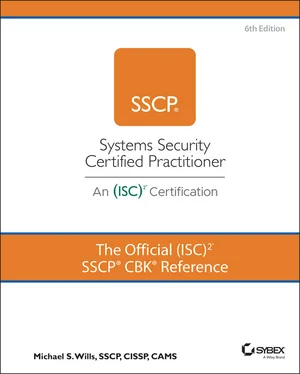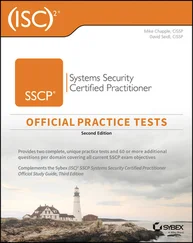Mike Wills - The Official (ISC)2 SSCP CBK Reference
Здесь есть возможность читать онлайн «Mike Wills - The Official (ISC)2 SSCP CBK Reference» — ознакомительный отрывок электронной книги совершенно бесплатно, а после прочтения отрывка купить полную версию. В некоторых случаях можно слушать аудио, скачать через торрент в формате fb2 и присутствует краткое содержание. Жанр: unrecognised, на английском языке. Описание произведения, (предисловие) а так же отзывы посетителей доступны на портале библиотеки ЛибКат.
- Название:The Official (ISC)2 SSCP CBK Reference
- Автор:
- Жанр:
- Год:неизвестен
- ISBN:нет данных
- Рейтинг книги:4 / 5. Голосов: 1
-
Избранное:Добавить в избранное
- Отзывы:
-
Ваша оценка:
- 80
- 1
- 2
- 3
- 4
- 5
The Official (ISC)2 SSCP CBK Reference: краткое содержание, описание и аннотация
Предлагаем к чтению аннотацию, описание, краткое содержание или предисловие (зависит от того, что написал сам автор книги «The Official (ISC)2 SSCP CBK Reference»). Если вы не нашли необходимую информацию о книге — напишите в комментариях, мы постараемся отыскать её.
The Official (ISC)2 SSCP CBK Reference
SSCP Study Guide
The Official (ISC)2 SSCP CBK Reference
The Official (ISC)2 SSCP CBK Reference — читать онлайн ознакомительный отрывок
Ниже представлен текст книги, разбитый по страницам. Система сохранения места последней прочитанной страницы, позволяет с удобством читать онлайн бесплатно книгу «The Official (ISC)2 SSCP CBK Reference», без необходимости каждый раз заново искать на чём Вы остановились. Поставьте закладку, и сможете в любой момент перейти на страницу, на которой закончили чтение.
Интервал:
Закладка:
Separate groups of user identities and accounts (for people and nonhuman elements of your systems) based on separation of duties.
Thoroughly examine all installed software, and connections to web or cloud-hosted applications platforms to identify any instances in which apps elevate privileges for nonprivileged users who use such apps or connection. Eliminate such elevation or find ways to explicitly control and restrict it.
Job Rotation and Privilege Creep
Job rotation can be a powerful HR investment strategy that leads to increasing the knowledge and skills of a company's workforce while improving retention of quality personnel, but these are not the concerns of the SSCP. From a security perspective, there are many reasons for creating a job rotation policy. These include reducing risks of both insider and external threats, reducing dependence on a single person (who can become a single point of failure), and increasing resiliency for business continuity and disaster recovery (BCDR) purposes. Banking and investment companies, for example, have used (and have sometimes been required by government regulators or by law) such career-broadening or rotations strategies as part of their loss control and fraud prevention mechanisms.
We cannot overstress the importance of carefully managing what should be the temporary changes in user privileges during such job rotations. Far too often, privilege creep resulting from each job rotation (temporary or permanent) ends up with the user accumulating new sets of privileges with each new task, job, or skills-broadening assignment. Over time, this can lead to an individual having far greater insight into and control over the organization's information assets than should ever be allowed.
In practice, job rotation requires cross-training personnel for various positions and tasks within the organization. This may be within a particular business functional area or discipline, or it might involve a temporary transfer of an employee to other areas within the company. Some of the personnel in the security office, for example, might all be trained on the various roles in that office (such as log analysis, incident response, security training, or systems testing) as an intra-departmental job rotation and then learn more of the company's human resources or product development business via a career-broadening assignment.
Job rotation helps to mitigate insider threats in several ways. It serves as a deterrent for a potentially malicious insider actually committing fraud. In cases where separation of duties would necessitate collusion, job rotation disrupts opportunities for collusion. In cases where a malicious insider has found a way to mishandle data or abuse their access, job rotation disrupts them from doing long-term damage once they've started. The cross-training aspect of job rotation may also aid the overall security effort by reducing the potential for employees/staff to become dissatisfied and possibly become insider threats; skilled personnel appreciate receiving additional training and challenges of new tasks, and increased training opportunities make those personnel more valuable. Increased morale of skilled personnel reduces costs because of turnover and accentuates loyalty to the organization.
Alternatives to job rotation are forced vacation or leave. The logic here is that if a malicious insider is suppressing alarms, changing or erasing audit logs, or conducting any other activity to cover their tracks or support or assist an attack, this activity should be easier to detect if the suspected insider is suddenly forced to stay away from work. During the period of mandatory vacation, that user's account access should be suspended, and a thorough audit/review of their activity should be performed. This is especially important for those users with privileged access. For example, after the U.S. stock market crash and the collapse of its banking systems in 1929, Congressional action established not only such forced vacations but also frequent bank holidays during which banks suspended customer transaction processing while they performed extensive internal systems integrity checks; both mitigated the risks of fraud, embezzlement, and over-extension by the bank or its staff.
Another goal of job rotation is to keep malicious outsiders from being able to learn about your staff over time and trying to target or manipulate them for information or access. Reducing static patterns in personnel taskings and changing access roles repeatedly reduces the opportunity for external actors to subvert particular employees as targets.
Finally, job rotation also greatly improves the resiliency of an organization, essential in successfully executing BCDR actions. During contingency events or disasters, you must assume that some personnel will not be available/capable of performing particular tasks and functions necessary to maintain the organization's critical processes; having other personnel not normally assigned to those functions but trained on how to perform them is a great benefit and vastly increases the likelihood of BCDR response success.
DOCUMENT, IMPLEMENT, AND MAINTAIN FUNCTIONAL SECURITY CONTROLS
Functional security controls implement the risk mitigation decisions that management and leadership have endorsed. The risk assessment and vulnerabilities assessment tasks have led to these decisions; now it's time to make appropriate cost-effective choices about particular controls, thus operationalizing those decisions by providing the tools, techniques, systems elements, and procedural step-by-step that the organization's workforce will need as they go about their day-to-day activities.
The organization has already made decisions about which risks to avoid (by not doing business in particular locations or by abandoning particular business processes); it's also recognized some risks must just be accepted as they are, as an unavoidable but still potential cost of doing business. Chapter 3, “Risk Identification, Monitoring, and Analysis” goes into further depth on how information risks are identified and assessed and how organizational leadership makes both strategic, big-picture risk management decisions, as well as planning for risk mitigation and making the resources available to carry out those plans. Management has also transferred what risks it can to other third parties to deal with. What's left are the risks that you and the rest of your organization's security professionals must deal with. You deal with risk using five basic types of controls: deterrent, preventative, detective, corrective, and compensating. Note that there are no hard and fast boundary lines between these types—a fence around the property both deters and prevents attackers from attempting to cross the fence line, while a network intrusion prevention system both detects and attempts to block (or prevent) intrusions on your networks.
Note that this section focuses on security controls, which are of course a subset of the larger problem of risk mitigation. From a security controls perspective, you think about these controls as interfering with a human attacker (or their software and hardware minions) who is carrying out an unauthorized intrusion into your information systems or causing damage or disruption to those systems.
Let's take a closer look at each type of control and then examine common issues involved with their implementation, maintenance, and operational use.
Deterrent Controls
Deterrent controls work to dissuade an attacker from initiating or continuing in their efforts to attack your systems, property, information, or people. Their design, deployment, and use should all raise either the perceived costs or risks to an attacker and the actual costs the attacker could face should they choose to persist. Guard dogs off of the leash, free to range around your property (but within a fence line), are an example of a deterrent that offers painful costs to an attacker, while raising the probability of being forcibly detained and subjected to arrest and prosecution as well.
Читать дальшеИнтервал:
Закладка:
Похожие книги на «The Official (ISC)2 SSCP CBK Reference»
Представляем Вашему вниманию похожие книги на «The Official (ISC)2 SSCP CBK Reference» списком для выбора. Мы отобрали схожую по названию и смыслу литературу в надежде предоставить читателям больше вариантов отыскать новые, интересные, ещё непрочитанные произведения.
Обсуждение, отзывы о книге «The Official (ISC)2 SSCP CBK Reference» и просто собственные мнения читателей. Оставьте ваши комментарии, напишите, что Вы думаете о произведении, его смысле или главных героях. Укажите что конкретно понравилось, а что нет, и почему Вы так считаете.












